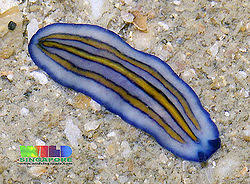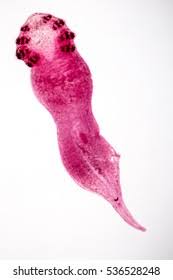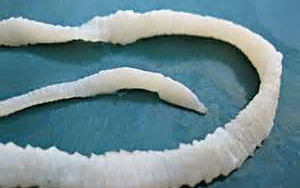Platyhelminthes: Difference between revisions
Created page with "==Platyhelminthes==" |
m The LinkTitles extension automatically added links to existing pages (<a rel="nofollow" class="external free" href="https://github.com/bovender/LinkTitles">https://github.com/bovender/LinkTitles</a>). |
||
| (24 intermediate revisions by one other user not shown) | |||
| Line 1: | Line 1: | ||
==Platyhelminthes== | ==Platyhelminthes== | ||
[[File:Turb.jpg|thumb| This is a turbellaria flatworm[5]]] | |||
== Overview== | |||
Platyhelminthes also known as acoelomate [[flatworms]] are triploblastic [[organisms]][1]. These flatworms can either be commensal or parasitic. These flatworms are divided into four different classes: Turbellaria, Monogenea, Trematoda and Cestoda[3]. | |||
==Description== | |||
Platyhelminthes are [[Triploblastic]] which means that these organisms are composed of three fundamental cell layers. The three layers are derived from embryonic germ layers and are known as the ectoderm, mesoderm, and endoderm[2]. These flatworms also have no body cavities other than their gut where they have a 2 way digestive system[1]. A two way digestive system means that their food and excretions come out of the same orifice or opening. | |||
---- | |||
==Turbellaria== | |||
This class of flatworms is typically free-living and aquatic. Although, there are some [[turbellaria]] that can live on land but the conditions must be moist and humid[4]. Free-living means that they do not need to parasitize a host for survival, unlike some of the other flatworms. These specific flatworms can range anywhere from a few millimeters to up to half a meter long[4]. Turbellaria are also hermaphrodites'. They contain both sperm and egg cells which are fertilized inside their body cavity. They fertilize the eggs by copulation, a process where the sperm is directly inserted into the females reproductive system[5]. | |||
---- | |||
==Monogenea== | |||
[[File:monogean.jpg|thumb||right| This is a Monogea flatworm [10]]] | |||
[[Monogenea]] are ectoparasitic(attach to the outside of a host) flatworms which are usually found on the fins, gills and scales of fish. They range from 5 millimeters up too several centimeters long but no longer than 10cm. Their lifecycle is the simplest among all platyhelminthes due to the fact that they do not have a need for an intermediate host to continue their lifecycle. Their eggs hatch in water and their larvae are known as oncomiracidium[6]. These oncomiracidium are heavily ciliated which allows them to move through the water to find and attach to a host. Before they can start maturing Monogenea need to use their posterior hooks to attach to their prey. | |||
---- | |||
==Trematoda== | |||
[[Trematodes]] are also more commonly known as flukes. Theses parasitic flatworms are known to infect both humans and [[animals]]. They contain both male and female reproductive systems which identifies them as [[hermaphrodites]][7]. These flatworms are usually found in the liver tissues, vascular systems or respiratory systems of domesticated animals and are known to cause cancers in the liver[7]. These flatworms can range from a couple millimeters long up to a few centimeters. A trematode uses multiple hosts throughout its life cycle, first using an intermediate host through its juvenile development and then using its definitive host for the rest of its life cycle until they reproduce and die. | |||
---- | |||
==Cestoda== | |||
[[File:tapeworm.jpg|thumb||right| Here you have a tapeworm which are common in household pets and can even be transmitted to humans.[9]]] | |||
[[Cestoda]] are a parasitic flatworm and the most commonly known Cestoda are from the subclass Eucestoda. Eucestoda are ribbon-like worms known as [[tapeworms]] when in the adult stage of their life. The flatworms have no digestive system, therefore they obtain nutrients by absorbing them through the body wall. Their life cycles can include up too three intermediate hosts before they reach their final adult stage of life[8]. Tapeworms can reach up to 15 meters long and can be found inside humans and animals. Alike the other classes of flatworms, Cestoda is hermaphroditic, containing both male and female reproductive systems. | |||
---- | |||
== Taxonomy== | |||
Kingdom: Animalia | |||
---- | |||
Subkingdom: Eumetazoa | |||
---- | |||
Phylum- Platyhelminthes | |||
---- | |||
Classes(4)- Turbellaria, Cestoda, Trematoda, Monogenea | |||
==Citations== | |||
[1] Introduction to the Platyhelminthes, ucmp.berkeley.edu/platyhelminthes/platyhelminthes.html. | |||
---- | |||
[2]Neupane, Laxmi, and Keerthana. “Phylum Platyhelminthes- Characteristics, Classification, Examples.” Microbe Notes, 25 Aug. 2020, microbenotes.com/phylum-platyhelminthes-flatworms/. | |||
---- | |||
[3] Learning, Lumen. “Biology for Majors II.” Lumen, courses.lumenlearning.com/wm-biology2/chapter/phylum-platyhelminthes/#:~:text=Platyhelminthes are traditionally divided into,and Cestoda (Figure 2). | |||
---- | |||
[4] “Class Turbellaria(Flatworms).” Class Turbellaria, jupiter.plymouth.edu/~lts/invertebrates/Primer/text/turbellaria.html. | |||
---- | |||
[5] “Turbellaria.” Wikipedia, Wikimedia Foundation, 20 Jan. 2021, en.wikipedia.org/wiki/Turbellaria | |||
---- | |||
[6] Smyth, James D. “Development.” Encyclopedia Britannica, Encyclopedia Britannica, Inc., www.britannica.com/animal/flatworm/Development#ref529410. | |||
---- | |||
[7] Jones, Brian F. “Trematoda.” Trematoda - an Overview | ScienceDirect Topics, www.sciencedirect.com/topics/immunology-and-microbiology/trematoda. | |||
---- | |||
[8] Class Cestoda (Tapeworms).” CLASS CESTODA, jupiter.plymouth.edu/~lts/invertebrates/Primer/text/cestoda.html#:~:text=Cestodes are long, flat, ribbon,segments, each containing reproductive organs. | |||
---- | |||
[9]Tony, Author Dr. “Tapeworms in Dogs and Cats.” Acupet Veterinary Care, 22 May 2015, acupetvetcare.com/veterinary-medicine/tapeworms-in-dogs-and-cats/. | |||
---- | |||
[10] “Monogeneans Images.” Shutterstock, www.shutterstock.com/search/monogeneans. | |||
---- | |||
Latest revision as of 13:08, 10 May 2023
Platyhelminthes

Overview
Platyhelminthes also known as acoelomate flatworms are triploblastic organisms[1]. These flatworms can either be commensal or parasitic. These flatworms are divided into four different classes: Turbellaria, Monogenea, Trematoda and Cestoda[3].
Description
Platyhelminthes are Triploblastic which means that these organisms are composed of three fundamental cell layers. The three layers are derived from embryonic germ layers and are known as the ectoderm, mesoderm, and endoderm[2]. These flatworms also have no body cavities other than their gut where they have a 2 way digestive system[1]. A two way digestive system means that their food and excretions come out of the same orifice or opening.
Turbellaria
This class of flatworms is typically free-living and aquatic. Although, there are some turbellaria that can live on land but the conditions must be moist and humid[4]. Free-living means that they do not need to parasitize a host for survival, unlike some of the other flatworms. These specific flatworms can range anywhere from a few millimeters to up to half a meter long[4]. Turbellaria are also hermaphrodites'. They contain both sperm and egg cells which are fertilized inside their body cavity. They fertilize the eggs by copulation, a process where the sperm is directly inserted into the females reproductive system[5].
Monogenea

Monogenea are ectoparasitic(attach to the outside of a host) flatworms which are usually found on the fins, gills and scales of fish. They range from 5 millimeters up too several centimeters long but no longer than 10cm. Their lifecycle is the simplest among all platyhelminthes due to the fact that they do not have a need for an intermediate host to continue their lifecycle. Their eggs hatch in water and their larvae are known as oncomiracidium[6]. These oncomiracidium are heavily ciliated which allows them to move through the water to find and attach to a host. Before they can start maturing Monogenea need to use their posterior hooks to attach to their prey.
Trematoda
Trematodes are also more commonly known as flukes. Theses parasitic flatworms are known to infect both humans and animals. They contain both male and female reproductive systems which identifies them as hermaphrodites[7]. These flatworms are usually found in the liver tissues, vascular systems or respiratory systems of domesticated animals and are known to cause cancers in the liver[7]. These flatworms can range from a couple millimeters long up to a few centimeters. A trematode uses multiple hosts throughout its life cycle, first using an intermediate host through its juvenile development and then using its definitive host for the rest of its life cycle until they reproduce and die.
Cestoda

Cestoda are a parasitic flatworm and the most commonly known Cestoda are from the subclass Eucestoda. Eucestoda are ribbon-like worms known as tapeworms when in the adult stage of their life. The flatworms have no digestive system, therefore they obtain nutrients by absorbing them through the body wall. Their life cycles can include up too three intermediate hosts before they reach their final adult stage of life[8]. Tapeworms can reach up to 15 meters long and can be found inside humans and animals. Alike the other classes of flatworms, Cestoda is hermaphroditic, containing both male and female reproductive systems.
Taxonomy
Kingdom: Animalia
Subkingdom: Eumetazoa
Phylum- Platyhelminthes
Classes(4)- Turbellaria, Cestoda, Trematoda, Monogenea
Citations
[1] Introduction to the Platyhelminthes, ucmp.berkeley.edu/platyhelminthes/platyhelminthes.html.
[2]Neupane, Laxmi, and Keerthana. “Phylum Platyhelminthes- Characteristics, Classification, Examples.” Microbe Notes, 25 Aug. 2020, microbenotes.com/phylum-platyhelminthes-flatworms/.
[3] Learning, Lumen. “Biology for Majors II.” Lumen, courses.lumenlearning.com/wm-biology2/chapter/phylum-platyhelminthes/#:~:text=Platyhelminthes are traditionally divided into,and Cestoda (Figure 2).
[4] “Class Turbellaria(Flatworms).” Class Turbellaria, jupiter.plymouth.edu/~lts/invertebrates/Primer/text/turbellaria.html.
[5] “Turbellaria.” Wikipedia, Wikimedia Foundation, 20 Jan. 2021, en.wikipedia.org/wiki/Turbellaria
[6] Smyth, James D. “Development.” Encyclopedia Britannica, Encyclopedia Britannica, Inc., www.britannica.com/animal/flatworm/Development#ref529410.
[7] Jones, Brian F. “Trematoda.” Trematoda - an Overview | ScienceDirect Topics, www.sciencedirect.com/topics/immunology-and-microbiology/trematoda.
[8] Class Cestoda (Tapeworms).” CLASS CESTODA, jupiter.plymouth.edu/~lts/invertebrates/Primer/text/cestoda.html#:~:text=Cestodes are long, flat, ribbon,segments, each containing reproductive organs.
[9]Tony, Author Dr. “Tapeworms in Dogs and Cats.” Acupet Veterinary Care, 22 May 2015, acupetvetcare.com/veterinary-medicine/tapeworms-in-dogs-and-cats/.
[10] “Monogeneans Images.” Shutterstock, www.shutterstock.com/search/monogeneans.